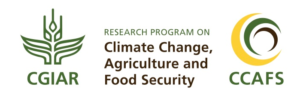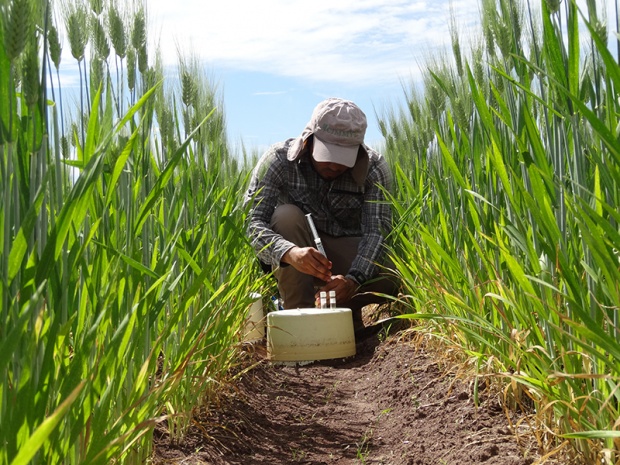 Article in collaboration with: CGIAR Research Program on Climate Change, Agriculture and Food Security (CCAFS) seeks to address the increasing challenge of global warming and declining food security on agricultural practices, policies and measures through strategic, broad-based global partnerships.
Article in collaboration with: CGIAR Research Program on Climate Change, Agriculture and Food Security (CCAFS) seeks to address the increasing challenge of global warming and declining food security on agricultural practices, policies and measures through strategic, broad-based global partnerships.
Seminal study on nitrous oxide emissions from fertilizer in large-scale irrigated wheat cropping systems shows that reducing nitrogen fertilizer rates significantly cuts emissions, without reducing grain yield or quality.
Farmers of irrigated wheat can increase profits and radically reduce greenhouse gas emissions by applying fertilizer in more precise dosages, according to a new study.
Published today in the journal Agriculture, Ecosystems and Environment, the study shows that farmers in the Yaqui Valley, a major breadbasket region in northwestern Mexico that covers over 1.5 times the area of the Mexico City, are applying significantly more nitrogen fertilizer than they need to maximize wheat yields.
Lower application of nitrogen fertilizer would cut the region’s yearly emissions of nitrous oxide, a potent greenhouse gas, by the equivalent of as much as 130,000 tons of carbon dioxide, equal to the emissions of 14 million gallons of gasoline, according to Neville Millar, a senior researcher at Michigan State University (MSU) and first author of the published paper.
“Our study is the first to isolate the effect of multiple nitrogen fertilizer rates on nitrous oxide emissions in wheat in the tropics or sub-tropics,” Millar said. “It shows that applying fertilizer to wheat at higher than optimal economic rates results in an exponential increase in nitrous oxide emissions.”
Results applicable in China, India, Mexico, and Pakistan
Yaqui Valley wheat farming conditions and practices are similar to those of huge wheat cropping expanses in China, India, and Pakistan, which together account for roughly half of worldwide nitrogen fertilizer use for wheat, according to study co-author Iván Ortíz Monasterio, a wheat agronomist at the International Maize and Wheat Improvement Center (CIMMYT), whose Yaqui Valley experiment station was the site of the reported research.
Related topics: Why There is No Climate Debate in American Politics – On Extinction, Food, Climate and Inequality – Today’s Challenges Affect Our Future Plate: Climate Change and Its Impact on Food
“The recommendations are globally relevant and represent a potential triple win, in the form of reduced greenhouse gas emissions, higher income for farmers and continued high productivity for wheat cropping,” Ortíz Monasterio said.
Measuring nitrous oxide after nitrogen fertilizer applications in spring durum wheat crops during two growing seasons, Millar and an international team of scientists found an exponential increase in emissions from plots fertilized at greater than economically-optimal rates—that is, when the extra nitrogen applied no longer boosts grain yield.
They also found that grain quality at the economically optimal N rates was not impacted and exceeded that required by local farmer associations for sale to the market. They examined five different nitrogen fertilizer dosages ranging from 0 to 280 kilograms per hectare.
“In our study, the highest dosage to get optimum wheat yields was 145 kilograms of nitrogen fertilizer per hectare in the 2014 crop,” said Millar. “Yaqui Valley farmers typically apply around 300 kilograms. The wheat crop takes up and uses only about a third of that nitrogen; the remainder may be lost to the atmosphere as gases, including nitrous oxide, and to groundwater as nitrate.”
Promoting fertilizer use that maximizes yields, saves farmers money, and decreases emissions
Farmers’ excessive use of fertilizer is driven largely by risk aversion and economic concerns, according to Ortíz Monasterio. “Because crops in high-yielding years will require more nitrogen than in low-yielding years, farmers tend to be optimistic and fertilize for high-yielding years,” said Ortíz Monasterio. “At the same time, since farmers don’t have data about available nitrogen in their fields, they tend to over-apply fertilizer because this is less costly than growing a crop that lacks the nitrogen to develop and yield near to full potential. Finally, in northwestern Mexico, farmer credit unions sell fertilizer and their approval is required before farmers can make ‘risky’ crop management changes like applying less fertilizer.”
Ortíz Monasterio and his partners have been studying and promoting management practices to help farmers to use fertilizer more efficiently and take into account available soil nitrogen and weather. This technology, including Greenseeker, a handheld device that assesses plant nitrogen needs, was tested in a separate study for its ability to advise farmers on optimal rates of fertilizer use.
“Sensing devices similar to Greenseeker but mounted on drones are providing recommendations to Yaqui Valley farmers for wheat crops grown on more than 1,000 acres in 2017 and 2018,” Ortiz Monasterio notes.
New emission factors to inform global markets
Part of a research partnership between CIMMYT and MSU’s W.K. Kellogg Biological Station (KBS) Long-Term Ecological Research program to reduce greenhouse gas impacts of intensive farming, a key aim of the present study was to generate new emission factors for Mexican grain crops that accurately reflect nitrous oxide emissions and emission reductions and can be used in global carbon markets, according to Millar.
“The emission calculations from our work can be incorporated by carbon market organizations into carbon market protocols, to help compensate farmers for reducing their fertilizer use,” he said.
“This study shows that low emissions nitrogen management is possible in tropical cereal crop systems and provides important guidance on the optimal levels for large cropping areas of the world,” said Lini Wollenberg, an expert in low-emissions agriculture for the CGIAR Research Program on Climate Change, Agriculture and Food Security (CCAFS), which helped fund the research. “With these improved emission factors, countries will be able to better plan and implement their commitments to reducing emissions.”
Read the study: Millar, N, Urrea A, Kahmark K, Shcherbak I, Robertson GP, Ortiz-Monasterio I. 2018. Nitrous oxide (N2O) flux responds exponentially to nitrogen fertilizer in irrigated wheat in the Yaqui Valley, Mexico. Agriculture, Ecosystems and Environment.
About the author: Mike Listman led writing of this piece, with input from the scientists who conducted the study, Lini Wollenberg and Julianna White. Mike Listman is Communications Officer for the CGIAR Research Program on Wheat and the International Maize and Wheat Improvement Center (CIMMYT). Lini Wollenberg is Flagship Leader and Julianna White is Program Manager for Low Emissions Development Research for the CGIAR Research Program on Climate Change, Agriculture and Food Security (CCAFS).
Editor’s Note: The opinions expressed here by Impakter.com columnists are their own, not those of Impakter.com — Featured Photo Credit: MSU









